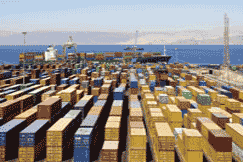| |
|
| |
|
 |
Supply
Chain by the Numbers |
| |
|
| |
- Oct. 9, 2014 -
|
| |
|
| |
|
| |
|
| |
UPS Asks Retailers to Cut Back Delivery Christmas Commitments; How Should Made in USA be Defined? Delays at Ports of LA and Long Beach a Big Concern; Machines to Eliminate 33% of Jobs by 2025 |
| |
|
| |
| |
| |
3 |

|
|
|
| |
| |
|
14
|
 |
Number of days it can take right now to get a container off a ship and onto a train headed to a Sears distribution center at the ports of LA and Long Beach. That according to Bob Wysocki, divisional vice president of international transportation and operations at Sears, at a recent conference on port "congestion" held by the Federal Maritime Commission. "We can't keep doing this," Wysocki said, noting the delays are especially acute for goods that are scheduled for promotional pricing campaigns and may not hit store shelves in time. The cause? Giant megaships that take much longer to unload, but maybe even more consequential the change in how the chasses used to move the containers at a terminal are managed, after the container lines exited the business and leasing companies took over.
|
| |
| |
|
| |
| |
33% |
|
Number of today's jobs for which humans will be replaced by robots, drones, super smart computers and other related technology by 2025, in a not exactly pleasant prediction from the analysts at Gartner this week. Take drones, for example. "In five years, drones will be a standard part of operations in many industries, used in agriculture, geographical surveys and oil and gas pipeline inspections,"
Gartner says, replacing jobs humans do currently. New cognitive capability in computer software will extend to even more areas than today, including financial analysis, medical diagnostics and data analytic jobs of all sorts, says Gartner, while robots will replace humans on the factory and warehouse floor. Gartner is probably right, but it is not exactly cheery news for the economy and the middle class.
|
| |
| |
|
|
|
| |
 |
 |
| |
|
|
| |